![]()
![]()
![]()
Use LEFT and RIGHT arrow keys to navigate between flashcards;
Use UP and DOWN arrow keys to flip the card;
H to show hint;
A reads text to speech;
54 Cards in this Set
- Front
- Back
|
Taxons |
categories based on similiaries between organisms based on genetic differences. R.N.A. most important (mutates less) D.N.A. and T.R.N.A. Cell membrane components (lipids) Cell wall components and antibiotic sensitivity (go together) Antiboitics affect different ribsosomes |
|
|
All species inventory |
Started in 2001 to discover and classify all living things. Only 10% currently discovered |
|
|
Phylogeny |
Evolutionary history |
|
|
Domains |
Above kingdoms. Based on cell types and chemical composition The three domains are: |
|
|
Eukarya |
Eukaryotes. Only eukaryotic domain
Fungi, Prostia, plants, animals Membrane bound organelles and nucleaus 80s ribosomes. 70s ribosomes in mitochondria and chloroplasts No anitibiotic sensitivity - no peptidoglycan cell wall (exception: sensitive to 70s ribosome antibiotics for organelles) |
|
|
Eubacteria |
"True Bacteria" Aka Bacteria. 70s ribosomes YES antibiotic sensitivity (generally) due to peptidoglycan cell wall |
|
|
Archea |
Prokaryotes that live in extreme environments example : Methanogens, halophiles, hyperthermophiles 70s ribosomes Non disease causing. No peptidoglycon if there is a cell wall No anitibiotic sensitivity - no peptidoglycan cell wall Halophiles - salt marshes methanogens - methan producing eg. swamps hyperthermophiles - extreme temps |
|
|
Endosymbiosis |
Eukaryotes evolved from prokaryotes. Prokaryotes formed 3.5 billion years ago Eukaryotes 1.2-2.0 billion years ago The mitochondria of eukaryotes evolved from aerobic bacteria living within their host cell. |
|
|
Gram + vs gram - |
Eubacteria . Gram positive have thicker peptitogylcal cell walls (protein and sugar) Gram negative have less peptitglyco and an outer lipid layer |
|
|
Characteristics: |
DNA, Histones, ribosomes, growth, cell wall, antibiotic sensitivity |
|
|
Cell type characteristics: Ribosomes: |
Prokaryotes: 70s ribosomes Eukaryotes: 80s in the cytosol and RER... 70s in mitrochondria and cholorplasts (endosymbiosis) |
|
|
Cell type characteristics: Histones |
Histones are proteins found in eukarya and archea Eukarya: YES |
|
|
Cell type characteristics: Growth |
Eukarya: Binary fission EuBacteria: Mitosis Archea: Binary fission |
|
|
Taxonomy |
The science of naming and classifying organisms, showing the degree of relatedness taxons: subcategories/groups |
|
|
Taxonomy heirarchy
|
Eukaryotes: k.p.c.o.f.g.s. Prokaryotes: d.p.c.o.f.g.s.s. Kingdom (or domain for prokaryotes), phylum, class, order, family, genus, species, subspecies (prokaryotes) KING PHILLIP CAME OVER FOR GOOD SOUP |
|
|
Prokaryote taxonomy |
Archea and bacteria are in Archea prokarytote or bacteria prokaryote kinggom Number's and letters after the genus and species signify subspecies or strain . Derived from the same parent cell but geneticaly different. Species is the population of cell with similar characteristics. There is only a subspecies if another genetic difference has been found |
|
|
Culture |
Bacteria grown in a medium (auger or broth) over a time in a vessel |
|
|
Clone |
Bacteria genetically the same. Pure but decedents of a single parent cell |
|
|
Viruses |
Viral presence speculated until the electron microscope non living (no cell structure, cytoplasm or organelles). Core contains genetic material, and have capsid (protein coat) Classification important to see how to prevent them and how they affect the body |
|
|
Classifying viruses |
Classified by: The configuration of genetic material (single or double stranded, circular, fragmented) Type of protein (capsulmere) that makes up capsid Shape of capsid disease it causes |
|
|
Morphology
|
Microscope morphology (looking under scope) Shape (cocci, bacillis, spiral) Arrangement (colony they take on Staining - gram + or gram negative |
|
|
Biochemistry test
|
Use of metabolic characteristics to ID. Ex. Enterotube |
|
|
Enterotube
|
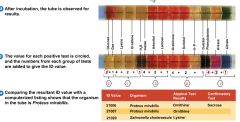
biochemistry test for an unknown bacterium. ID given for each positive result (enzyme activity) which indicate certain genes which are specific for each bacterium |
|
|
Serology
|
ex ELISA |
|
|
ELISA |

Checking for antibody or antigen - need positive and negative control to ensure good test Indirect tests: Looking for antibody (HIV/Lyme) Direct test: Looking for antigen |
|
|
Western Blot
|
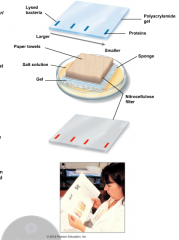
ID's proteins to ID organism |
|
|
Phage typing |
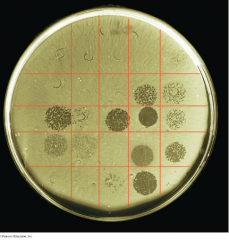
Petri dish/grid and Bacteria lawn. Phage is a virus that affects bacteria, causing them to rupture. What's left is a clearing zone called a plaque. Known number of viral agents that affect bacteria. Compare to ID bacteria. |
|
|
Fatty acid profile
|
Compares fatty acids that are produced by one bacterium to another bacterium or known body of information to ID. |
|
|
Flow cytometry
|
FLuid (eg: contaminated milk) forced through small hole and computer measures small particles that pass through - how they conduct electrons or scatter light and compare to known body of information |
|
|
DNA Fingerprinting
|
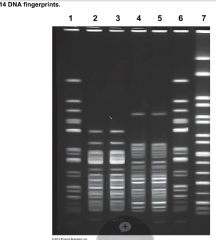
Augarose gel. ID Comparisons, restriction enzymes. Chop DNA and place in well (compare blood in crimescenes, scheme of evolution) |
|
|
PCR
|
Polymerase chain reaction. Amplifies DNA by photocopying in order to run multiple tests on the same sample |
|
|
rRNA Sequencing |
rRNA mutates less. Look at base sequence to compare evolution
|
|
|
DNA hybridization |
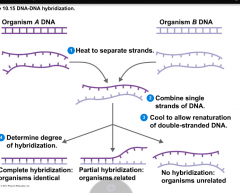
C-G pairing and A-T pairing Called G+C ratio or percent If the G+C ratio is less than 10% difference they are similar organisms |
|
|
DNA probes |
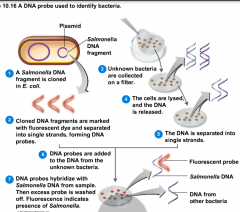
Flouresent test. Glow in the dark pigment. GLows if it combined
|
|
|
DNA chips
|
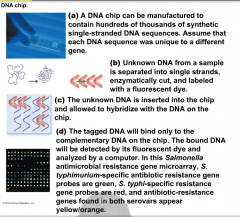
Chip filled with multiple single strand DNA. Fluorescent dye added. Glows if hybridized
|
|
|
Southern blot
|
Molten Auger, comb to make wells (electrophoresis). Chambers negative to positive Banding patterns |
|
|
Western vs southern blot
|
Southern: DNA fragments |
|
|
Dichotomous keys |
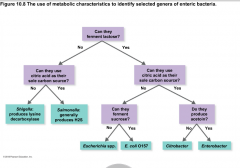
ID organisms but does not show evolutionary history Ask questions, preform tests and get answers and compare to known information Yes or No = Di |
|
|
Cladogram |
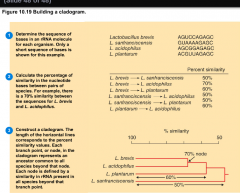
Each node shows a common ancestor Divided earlier = less in common |
|
|
What is the phylogeneticclassification of microorganisms based on? |
Taxons
|
|
|
Whatare the characteristics of Archea bacteria? |
Live in extremeenvironments (salt marshes and swamps). No peptidoglycan in the cell wall IFthere is a cell wall. 70s ribosomes, histones, and no antibiotic sensitivity. Do not cause disease |
|
|
Whenin history did the first prokaryotes exist?
|
3.5 billionyears ago. Eukaryotes 1.2-2.0 billion |
|
|
Describe the principals behindnucleic acid hybridization. |
Heat toseparate and let cool to see what naturally combines. Complete hybridization =identical. G+C ratio less than 10% difference means they are related |
|
|
Beable to read, understand, and interpret cladograms and electrophoresis gels
|
** |
|
|
Describe the characteristics ofviruses. |
Non livingbecause no cell structure, cytoplasm or organelles. Speculated existence untilelectron microscope. Core is DNA or RNA, not both. Capsulmere that makes up thecapsid is protein. No kingdoms or domains. |
|
|
What do Eubacteria have that Archealack? |
Peptidoglycancell wall |
|
|
What are the differences between 70sand 80s ribosomes? Where are they found? |
70s arefound in prokaryotes and eukaryotic mitochondria and chloroplasts. 80s is foundin eukaryotic. *difference? |
|
|
What are the 3 domains? Classification intoone of the 3 domains is based on what? |
Eukaryote,Eubacteria, Archea. Classified based on cell type (eukaryotic and prokaryotic) |
|
|
Whatcan you conclude about 2 organisms that share similar rRNA sequences |
That theyhave similar evolutionary history, and evolved from the same or similar organism |
|
|
List the taxonomic groupingsbeginning with kingdom. |
Kingdom,Phyllum, Class, Order, Family, Genuis, Species |
|
|
What is phage-typing ? What do theresults of a phage-typing experiment tell us? |
Petri dish/grid and Bacteria lawn. Phage is avirus that affects bacteria, causing them to rupture. What's left is a clearingzone called a plaque. Known number of viral agents that affect bacteria.Compare to ID bacteria. * |
|
|
1.
What is serology? |
Antibody/antigentest interactions. Slide augglution, elisa* |
|
|
1.
What is a bacterial “clone”? |
Geneticallythe same. Descendent of a single parent cell. |
|
|
What does a bacterial biochemicaltest indicate? |
Thebacterial enzyme uses metabolic characteristics to ID |

